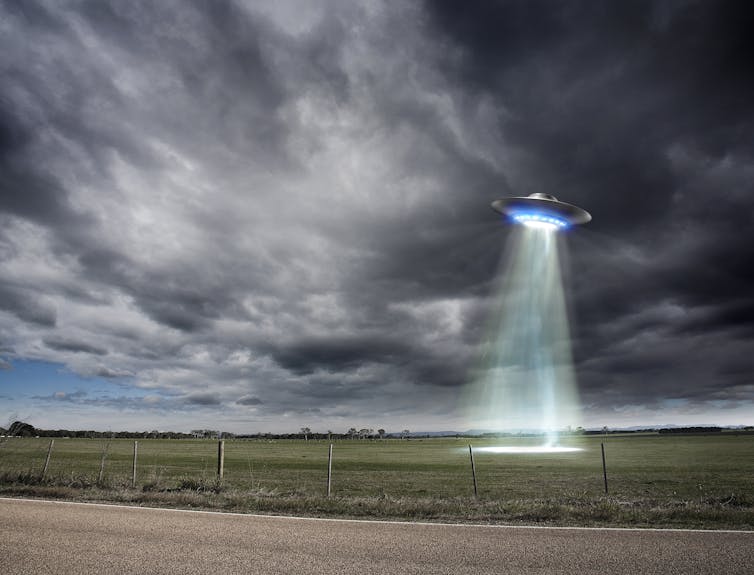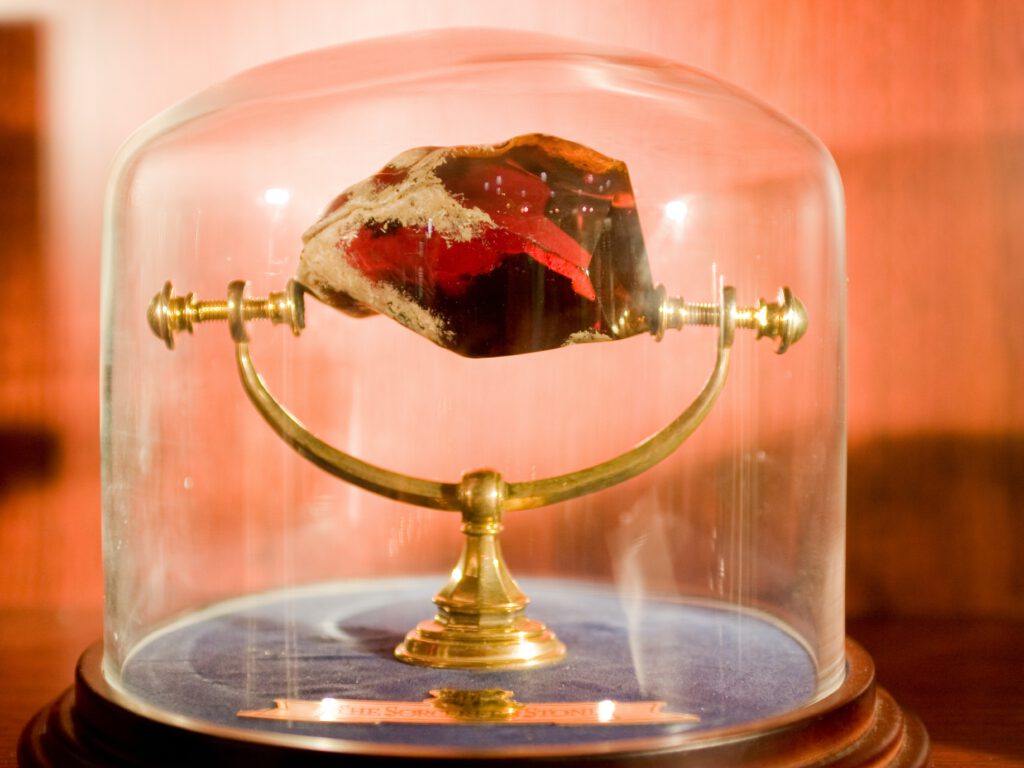I’m an astronomer and I think aliens may be out there – but UFO sightings aren’t persuasive

Chris Impey, University of Arizona
If intelligent aliens visit the Earth, it would be one of the most profound events in human history.
Surveys show that nearly half of Americans believe that aliens have visited the Earth, either in the ancient past or recently. That percentage has been increasing. Belief in alien visitation is greater than belief that Bigfoot is a real creature, but less than belief that places can be haunted by spirits.
Scientists dismiss these beliefs as not representing real physical phenomena. They don’t deny the existence of intelligent aliens. But they set a high bar for proof that we’ve been visited by creatures from another star system. As Carl Sagan said, “Extraordinary claims require extraordinary evidence.”
I’m a professor of astronomy who has written extensively on the search for life in the universe. I also teach a free online class on astrobiology. Full disclosure: I have not personally seen a UFO.
Unidentified flying objects
UFO means unidentified flying object. Nothing more, nothing less.
There’s a long history of UFO sightings. Air Force studies of UFOs have been going on since the 1940s. In the United States, “ground zero” for UFOs occurred in 1947 in Roswell, New Mexico. The fact that the Roswell incident was soon explained as the crash landing of a military high-altitude balloon didn’t stem a tide of new sightings. The majority of UFOs appear to people in the United States. It’s curious that Asia and Africa have so few sightings despite their large populations, and even more surprising that the sightings stop at the Canadian and Mexican borders.
Most UFOs have mundane explanations. Over half can be attributed to meteors, fireballs and the planet Venus. Such bright objects are familiar to astronomers but are often not recognized by members of the public. Reports of visits from UFOs inexplicably peaked about six years ago.
Many people who say they have seen UFOs are either dog walkers or smokers. Why? Because they’re outside the most. Sightings concentrate in evening hours, particularly on Fridays, when many people are relaxing with one or more drinks.
A few people, like former NASA employee James Oberg, have the fortitude to track down and find conventional explanations for decades of UFO sightings. Most astronomers find the hypothesis of alien visits implausible, so they concentrate their energy on the exciting scientific search for life beyond the Earth. https://www.youtube.com/embed/lAopNJMbFEI?wmode=transparent&start=0 Most UFO sightings have been in the United States.
Are we alone?
While UFOs continue to swirl in the popular culture, scientists are trying to answer the big question that is raised by UFOs: Are we alone?
Astronomers have discovered over 4,000 exoplanets, or planets orbiting other stars, a number that doubles every two years. Some of these exoplanets are considered habitable, since they are close to the Earth’s mass and at the right distance from their stars to have water on their surfaces. The nearest of these habitable planets are less than 20 light years away, in our cosmic “back yard.” Extrapolating from these results leads to a projection of 300 million habitable worlds in our galaxy. Each of these Earth-like planets is a potential biological experiment, and there have been billions of years since they formed for life to develop and for intelligence and technology to emerge.
Astronomers are very confident there is life beyond the Earth. As astronomer and ace exoplanet-hunter Geoff Marcy, puts it, “The universe is apparently bulging at the seams with the ingredients of biology.” There are many steps in the progression from Earths with suitable conditions for life to intelligent aliens hopping from star to star. Astronomers use the Drake Equation to estimate the number of technological alien civilizations in our galaxy. There are many uncertainties in the Drake Equation, but interpreting it in the light of recent exoplanet discoveries makes it very unlikely that we are the only, or the first, advanced civilization.
This confidence has fueled an active search for intelligent life, which has been unsuccessful so far. So researchers have recast the question “Are we alone?” to “Where are they?”
The absence of evidence for intelligent aliens is called the Fermi Paradox. Even if intelligent aliens do exist, there are a number of reasons why we might not have found them and they might not have found us. Scientists do not discount the idea of aliens. But they aren’t convinced by the evidence to date because it is unreliable, or because there are so many other more mundane explanations.
Modern myth and religion
UFOs are part of the landscape of conspiracy theories, including accounts of abduction by aliens and crop circles created by aliens. I remain skeptical that intelligent beings with vastly superior technology would travel trillion of miles just to press down our wheat.
It’s useful to consider UFOs as a cultural phenomenon. Diana Pasulka, a professor at the University of North Carolina, notes that myths and religions are both means for dealing with unimaginable experiences. To my mind, UFOs have become a kind of new American religion.
[Deep knowledge, daily. Sign up for The Conversation’s newsletter.]
So no, I don’t think belief in UFOs is crazy, because some flying objects are unidentified, and the existence of intelligent aliens is scientifically plausible.
But a study of young adults did find that UFO belief is associated with schizotypal personality, a tendency toward social anxiety, paranoid ideas and transient psychosis. If you believe in UFOs, you might look at what other unconventional beliefs you have.
I’m not signing on to the UFO “religion,” so call me an agnostic. I recall the aphorism popularized by Carl Sagan, “It pays to keep an open mind, but not so open your brains fall out.”
Chris Impey, University Distinguished Professor of Astronomy, University of Arizona
This article is republished from The Conversation under a Creative Commons license. Read the original article.
Gay conversion therapy: proposed ban is a positive step but the battle remains to be won

Stella Coyle, Keele University
Conversion therapy – sometimes known as “reparative therapy” or “gay cure therapy” – claims to alter a person’s sexual orientation from gay to straight. The practice is based on the mistaken idea that gay people suffer a traumatic experience early in life that has damages them and that homosexuality is a “reparative drive” to overcome this early trauma.
In the UK, practitioners are legally allowed to promote and provide conversion therapy. But, hopefully, not for much longer. The UK government has announced plans to ban conversion therapy as part of its LGBT action plan.
Attempts to “cure” homosexuality were not always couched in the language of therapy. In the early 20th century, medical professionals believed that homosexuality was a birth defect. One “treatment” involved replacing a testicle of a homosexual man with one from a heterosexual man. Later methods included lobotomies and chemical castration – a method used on Alan Turing, the Enigma codebreaker.
Homosexuality later came to be seen as a condition that could be “treated” psychologically – although this doesn’t mean that the methods used were any more humane.
In the 1950s and 60s, when homosexuality was still illegal in the UK, the NHS routinely used aversion therapy on men convicted of homosexuality in an attempt to turn them straight. If they volunteered for this treatment, they could avoid a prison sentence. Volunteers – if they can be called that – were shown pictures of naked men and given either electric shocks or drugs that induced vomiting. The aim was to make them respond negatively to their homosexuality and thus to be “cured”.
Not a psychiatric condition
Homosexuality was removed from the American Psychiatric Association’s diagnostic manual in 1987 and from the World Health Organisation’s classification of mental disorders in 1992. Progress in this area has been slow.
In 2015, a memorandum of understanding stating that conversion therapy is unethical and potentially harmful was signed by representatives from the NHS, the Royal College of Psychiatrists and the major counselling and psychotherapy organisations in the UK.
Being gay is not a disease and there is no sound evidence that sexual orientation can be changed by “conversion therapy”. Also, “treating” homosexuality sustains the prejudice and discrimination that gay people already face in society.
Gay people who seek to change their sexuality do so because of internalised homophobia and because of the dangers and pressures arising from this external prejudice and discrimination. An example of the potential harm is seen in a 2002 study
of 202 men, which found that the practice had led 34 of them to attempt suicide either during or after “conversion therapy”.
Co-opting the language of sexual fluidity
These days “conversion therapy” is generally advocated by religious groups, such the Core Issues Trust, a UK organisation that “works with people who seek to change from a ‘gay’ lifestyle to a gender-affirming one”.
In common with National Association for Research and Therapy of Homosexuality in the US (an organisation that advocates the use of conversion therapy in the US), the Core Issues Trust advocates for the right of people to have access to this service if they want it. They use the language of rights, autonomy and client choice, arguing that a ban would deny them a “human right to treatment intended to help them shape their lives as they wish”.
They have also co-opted the language of sexual fluidity as justification for their assertion that the practice works. This misunderstands what is meant by sexual fluidity.
People are born with both a sexual orientation and a degree of sexual flexibility that varies from person to person. Some people are fixedly gay or straight, but others are more fluid and can experience attractions that run outside of their general sexual orientation. Sexual fluidity is the capacity to experience sexual attraction that runs counter to your orientation.
There is now mounting evidence that gay people are born gay, as a clear link has been found between sexual orientation – at least in men – with two regions of the human genome.
Which way now?
After years of campaigning and legal pressure, the UK government is finally going to follow the example of some other European countries and states in Canada, Australia and the US, and ban the practice of “conversion therapy”. It will be interesting to see how the debate develops as the legislation proceeds through parliament.
The NHS and the major psychiatric, counselling and psychotherapy organisations are already opposed to the practice. But if the counselling profession remains unregulated – meaning anyone, including religious groups and individuals, can offer “counselling” – how will the ban be enforced? The battle is not yet won.
Stella Coyle, Teaching Fellow in Law, Keele University
This article is republished from The Conversation under a Creative Commons license. Read the original article.
[Top]The Legend of ‘Lapis Philosophorum’ aka the Philosopher Stone
By Maria Anna van Driel, www.medium.com

The concept of being able to turn metals into gold attracted the attention of many who saw the legend of the stone as a chance to make a fortune. And so, many of the world’s brilliant minds searched for the Philosopher’s Stone over the centuries including Robert Boyle who is considered the father of modern day chemistry.
There are many descriptions of the stones appearance. The most well-known being a red stone but it was also referred to as an orange stone. When the stone is in its solid form it often appears as a transparent and glass-like object in the shape of an egg. But there are many sources that believe the Philosopher’s Stone may not have even been a stone at all.
When searching for the stone, alchemists examined countless substances what has build the base knowledge for fields we know today as chemistry and pharmacology.
When discussing the philosopher’s stone the one name you will not miss is Nicolas Flamel. Flamel was a French scribe and manuscript-seller who lived in Paris during the 14th and 15th century and, in 1382, claimed to have transformed lead into gold after decoding an ancient book of alchemy. We most likely will never know if this was true. However the historical record show that Flamel did come into considerable wealth around the time he made his claim but donated all of his riches to charity.
The medieval kitchen of alchemy aka ‘Physical chemistry’
The commencement of deciphering this ‘key’ is the dismembering of the word ALCHEMY; Al-Khemet means ‘From Egypt’, Khemet means ‘Black’, Khem means ‘chem’ or ‘chemical’
Later in history this ancient Egyptian word Al-Khemet has been translated into ‘the black art through Alchemy’ a term many might know today as the medieval and dangerous ‘black magic’. Even it is being thought by some that a Pagan mystery as such is spawned by the devil’s hand, less is true in this legend of the stone of the ancients.
Click here to read the full article via medium.com
[Top]
